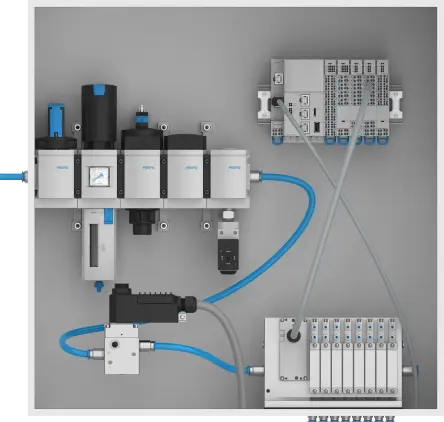自動化製氫的兩種方式
電解槽有兩種自動化方式:集中式和分散式結構。 兩者都追求安全、高效製氫, 區別只在於裝置的設計和控制。

集中式自動化
集中式自動化透過中央控制櫃進行控制。 全部感測器、執行機構和閥透過電纜連接,由中央控制系統進行操作和控制。 如此不但能讓結構條理分明、一目了然,而且便於維護 — 在空間有限的情況下,這種解決方案可以節省空間。

分散式自動化
採用分散式方案時,智慧自動化元件直接安裝在各個製程中。 因此,裝置的控制系統分散在多個模組或單元上 — 可以是不同裝置中的閥島或 I/O 模組。 如此不但能節省控制櫃空間、減少佈線工作量,也可輕鬆完成裝置的模組化擴展。
集中式、分散式或者兩者結合?
完全取決於具體的環境條件。 集中式解決方案通常是精巧型電解槽的明智選擇。 而對於配備組合式模組的大型裝置來說,分散式往往更為合適。 當然,您也可以將這兩種方案組合使用。 為何不利用兩種架構的優勢,實現您的個人想法?
Are decentralised systems too complex?
Many people think that decentralised automation is difficult to manage. However, modern systems are easy and intuitive to configure. This simplifies commissioning and ensures that system operation is stable, without any unnecessary interruptions.
Decision-making made easy
Festo will help you find the right control concept for your requirements. The focus is always on what solution is the best, regardless of the technology used. This means that the decision depends on your system and your requirements. What is certain, is that Festo offers everything from a single source, from components to the control cabinet.
Already successfully being used now
Our customers successfully use centralised and decentralised automation solutions to produce hydrogen. This not only reduces costs, but also increases the efficiency and safety of the processes, thus makinga real contribution to decarbonisation. Make the most of our experience.
Checklist: Which concept suits you?
☑ Is your system compact or distributed?
☑ Will you need to be able to scale it flexibly in the future?
☑ How much space is available for control technology?
☑ Would you like to reduce cabling and installation work?
☑ Is a combination of centralised and decentralised solutions an option?